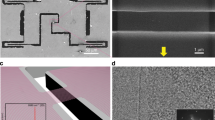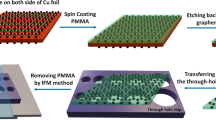Abstract
The recent discovery of graphene has sparked much interest, thus far focused on the peculiar electronic structure of this material, in which charge carriers mimic massless relativistic particles1,2,3. However, the physical structure of graphene—a single layer of carbon atoms densely packed in a honeycomb crystal lattice—is also puzzling. On the one hand, graphene appears to be a strictly two-dimensional material, exhibiting such a high crystal quality that electrons can travel submicrometre distances without scattering. On the other hand, perfect two-dimensional crystals cannot exist in the free state, according to both theory and experiment4,5,6,7,8,9. This incompatibility can be avoided by arguing that all the graphene structures studied so far were an integral part of larger three-dimensional structures, either supported by a bulk substrate or embedded in a three-dimensional matrix1,2,3,9,10,11,12. Here we report on individual graphene sheets freely suspended on a microfabricated scaffold in vacuum or air. These membranes are only one atom thick, yet they still display long-range crystalline order. However, our studies by transmission electron microscopy also reveal that these suspended graphene sheets are not perfectly flat: they exhibit intrinsic microscopic roughening such that the surface normal varies by several degrees and out-of-plane deformations reach 1 nm. The atomically thin single-crystal membranes offer ample scope for fundamental research and new technologies, whereas the observed corrugations in the third dimension may provide subtle reasons for the stability of two-dimensional crystals13,14,15.
This is a preview of subscription content, access via your institution
Access options
Subscribe to this journal
Receive 51 print issues and online access
$199.00 per year
only $3.90 per issue
Buy this article
- Purchase on SpringerLink
- Instant access to full article PDF
Prices may be subject to local taxes which are calculated during checkout




Similar content being viewed by others
References
Novoselov, K. S. et al. Electric field effect in atomically thin carbon films. Science 306, 666–669 (2004)
Novoselov, K. S. et al. Two-dimensional gas of massless Dirac fermions in graphene. Nature 438, 197–200 (2005)
Zhang, Y., Tan, J. W., Stormer, H. L. & Kim, P. Experimental observation of the quantum Hall effect and Berry's phase in graphene. Nature 438, 201–204 (2005)
Peierls, R. E. Bemerkungen über Umwandlungstemperaturen. Helv. Phys. Acta 7, 81–83 (1934)
Peierls, R. E. Quelques proprietes typiques des corpses solides. Ann. Inst. Henri Poincare 5, 177–222 (1935)
Landau, L. D. Zur Theorie der Phasenumwandlungen II. Phys. Z. Sowjetunion 11, 26–35 (1937)
Landau, L. D. & Lifshitz, E. M. Statistical Physics Part I, Sections 137 and 138 (Pergamon, Oxford, 1980)
Mermin, N. D. Crystalline order in two dimensions. Phys. Rev. 176, 250–254 (1968)
Novoselov, K. S. et al. Two-dimensional atomic crystals. Proc. Natl Acad. Sci. USA 102, 10451–10453 (2005)
Berger, C. et al. Electronic confinement and coherence in patterned epitaxial graphene. Science 312, 1191–1196 (2006)
Ohta, T., Bostwick, A., Seyller, T., Horn, K. & Rotenberg, E. Controlling the electronic structure of bilayer graphene. Science 313, 951–954 (2006)
Stankovich, S. et al. Graphene-based composite materials. Nature 442, 282–286 (2006)
Nelson, D. R. & Peliti, L. Fluctuations in membranes with crystalline and hexatic order. J. Phys. 48, 1085–1092 (1987)
Radzihovsky, L. & Le Doussal, P. Self-consistent theory of polymerized membranes. Phys. Rev. Lett. 69, 1209–1212 (1992)
Nelson, D. R., Piran, T. & Weinberg, S. Statistical Mechanics of Membranes and Surfaces (World Scientific, Singapore, 2004)
Born, M. & Huang, K. Dynamical Theory of Crystal Lattices (Clarendon, Oxford, 1954)
Mermin, N. D. & Wagner, H. Absence of ferromagnetism or antiferromagnetism in one- or two-dimensional isotropic Heisenberg models. Phys. Rev. Lett. 17, 1133–1136 (1966)
Venables, J. A., Spiller, G. D. T. & Hanbucken, M. Nucleation and growth of thin-films. Rep. Prog. Phys. 47, 399–459 (1984)
Zinkeallmang, M., Feldman, L. C. & Grabow, M. H. Clustering on surfaces. Surf. Sci. Rep. 16, 377–463 (1992)
Evans, J. W., Thiel, P. A. & Bartelt, M. C. Morphological evolution during epitaxial thin film growth: Formation of 2D islands and 3D mounds. Surf. Sci. Rep. 61, 1–128 (2006)
Horiuchi, S. et al. Carbon nanofilm with a new structure and property. Jpn. J. Appl. Phys. 42, L1073–L1076 (2003)
Buseck, P. R., Cowley, J. M. & Eyring, L. High-Resolution Transmission Electron Microscopy (Oxford Univ. Press, Oxford, 1988)
Spence, J. C. H. High-Resolution Electron Microscopy (Oxford Univ. Press, Oxford, 2003)
Peng, L. M. Electron atomic scattering factors and scattering potentials of crystals. Micron 30, 625–648 (1999)
Yu, M. F., Files, B. S., Arepalli, S. & Ruoff, R. S. Tensile loading of ropes of single wall carbon nanotubes and their mechanical properties. Phys. Rev. Lett. 84, 5552–5555 (2000)
Zhao, Q., Nardelli, M. B. & Bernholc, J. Ultimate strength of carbon nanotubes: a theoretical study. Phys. Rev. B 65, 144105 (2002)
Huang, J. Y. et al. Superplastic carbon nanotubes. Nature 439, 281 (2006)
Morozov, S. V. et al. Strong suppression of weak localization in graphene. Phys. Rev. Lett. 97, 016801 (2006)
Doyle, P. A. & Turner, P. S. Relativistic Hartree-Fock x-ray and electron scattering factors. Acta Crystallogr. A 24, 390–397 (1968)
Acknowledgements
We thank B. Freitag and D. Beamer of FEI for providing access to their in-house TEM Titan. This work was supported by the EU project CANAPE, the EPSRC (UK) and the Royal Society. M.I.K. acknowledges financial support from FOM (Netherlands).
Author information
Authors and Affiliations
Corresponding authors
Ethics declarations
Competing interests
Reprints and permissions information is available at www.nature.com/reprints. The authors declare no competing financial interests.
Supplementary information
Supplementary Information
This file contains Supplementary Notes and Supplementary Figures S1-S5 with Legends (PDF 5004 kb)
Rights and permissions
About this article
Cite this article
Meyer, J., Geim, A., Katsnelson, M. et al. The structure of suspended graphene sheets. Nature 446, 60–63 (2007). https://doi.org/10.1038/nature05545
Received:
Accepted:
Issue Date:
DOI: https://doi.org/10.1038/nature05545
This article is cited by
-
Electrochemical-repaired porous graphene membranes for precise ion-ion separation
Nature Communications (2024)
-
High-entropy engineering of the crystal and electronic structures in a Dirac material
Nature Communications (2024)
-
Novel bilayer 2D V2O5 as a potential catalyst for fast photodegradation of organic dyes
Scientific Reports (2024)
-
Bending rigidity, sound propagation and ripples in flat graphene
Nature Physics (2024)
-
Transcending catalytic limits for methane decomposition: multi-functional basalt fiber-supported catalysts with membrane synergy
Advanced Composites and Hybrid Materials (2024)




